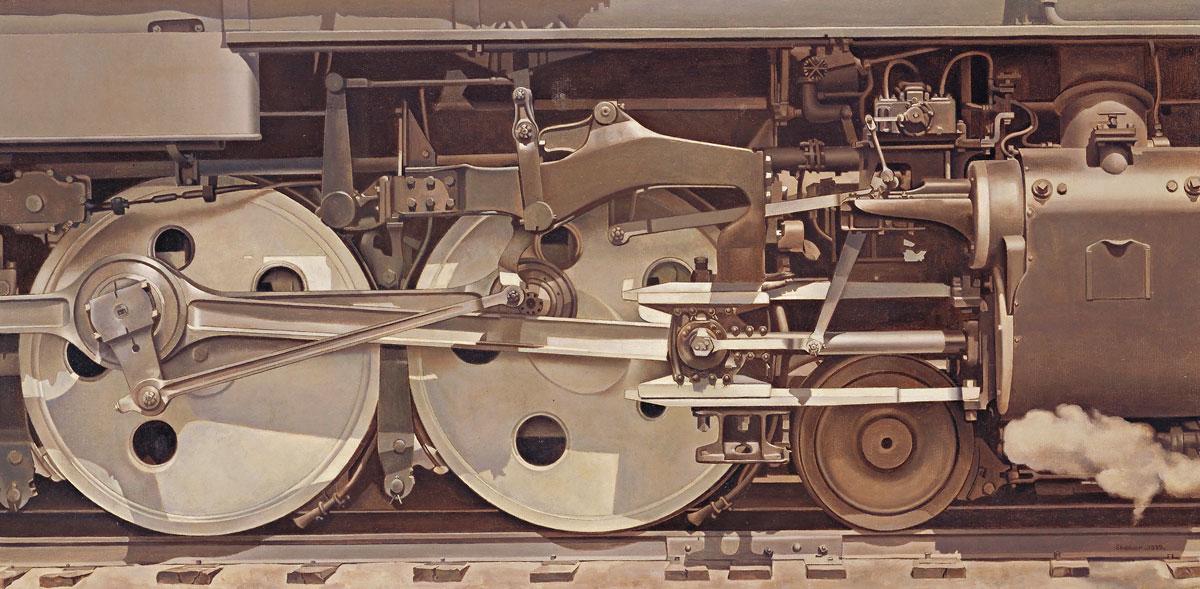
Charles Sheeler, "Rolling Power," 1939. Oil on canvas, 15 x 30 in. The Smith College Museum of Art, SC 1940:18
Cult of the Machine: Precisionism and American Art
de Young | March 24–August 12, 2018
SAN FRANCISCO (November 13, 2017) – The Fine Arts Museums of San Francisco (FAMSF) are proud to announce Cult of the Machine: Precisionism and American Art, the first large-scale exhibition in over 20 years to survey this characteristically American style of early twentieth-century Modernism. Organized by FAMSF and on view at the de Young, the exhibition will address the aesthetic and intellectual concerns that fueled the development of this artistic style during the 1920s and 1930s. More than 100 Precisionist masterworks by seminal artists such as Charles Sheeler, Georgia O’Keeffe, and Charles Demuth will be displayed alongside prints by photographers such as Imogen Cunningham and Paul Strand; clips from films such as Charlie Chaplin’s Modern Times; and extraordinary decorative arts and industrial objects from the period—including a vintage Cord Phaeton automobile—to reflect the widespread embrace of a machine-age aesthetic by artists, designers, and the public alike. Cult of the Machine will consider how the style reflects the economic and social changes wrought by industrialization and technological progress during the Machine Age in America. Visitors will be encouraged to draw connections to our own technological moment, one in which optimism and dreams about what technological progress can achieve are tempered with anxiety or suspicion about its potential dangers and misuses.
“This project will resonate here in the heart of the Bay Area, at the epicenter of the emerging tech industries of Silicon Valley,” says Max Hollein, Director and CEO of the Fine Arts Museums. “We, like our visitors, often reflect on how our daily lives are impacted by new technologies—much as the Precisionists did almost a century ago. Aesthetically, these works are masterpieces, but perhaps they represent something more. Like all great works of art, they transcend their historical moment and give us insights about both our present and our future.”
The majority of Precisionist works were created during the tumultuous period between the World Wars, decades when the country’s new technologies and indus¬tries were met with multiple and contradictory responses in the arts, literature, and popular culture. As today, there was a general excitement in the United States about technology’s capac¬ity to engender opportunity and improve the conditions of daily life, yet these attitudes coexisted with fears that it would supplant human labor and deaden the natural rhythms of life. Precisionist artists reflected such contradictions and complexities in their work, capturing a sense of the beauty and the coldness, the sublimity and the strangeness of the mechanistic societies in which they lived.
“The responses to industrialization in these works are particularly fascinating and relevant to contemporary audiences who find themselves in the midst of a fourth industrial revolution,” says Emma Acker, associate curator of American art for the Fine Arts Museums. “They hold up a mirror to our own complicated responses to the legacies of industrialization and technological progress as we continue to navigate our relationships with the ever-multiplying devices that surround us and shape our daily existence.”
Precisionism emerged in America in the teens and flourished during the 1920s and 1930s. The style combined realist imagery with abstracted forms and married the influence of avant-garde European art styles such as Purism, Cubism, and Futurism with American subject matter. Artists as¬sociated with the style typically produced highly structured, geometric compositions with smooth surfaces and lucid forms to create a streamlined, “machined” aesthetic, with themes ranging from the urban and industrial to the pastoral.
Masterpieces of machine age Modernism will be on loan from more than 50 institutions from across the United States, including the Amon Carter Museum of American Art, Brooklyn Museum of Art, Dallas Museum of Art, Harvard Art Museums, National Gallery of Art, Nelson-Atkins Museum of Art, Walker Art Center and many others.
Cult of the Machine is curated by Emma Acker, associate curator of American Art for the Fine Arts Museums of San Francisco. It will be on view at de Young from March 24 through August 12, 2018. The exhibition will then travel to the Dallas Museum of Art, where it will be on view from September 9, 2018, through January 6, 2019.
Visiting | de Young
Golden Gate Park, 50 Hagiwara Tea Garden Drive, San Francisco. Open 9:30 a.m.– 5:15 p.m. Tuesdays–Sundays. Open select holidays; closed most Mondays.
Exhibition Organization
This exhibition is organized by the Fine Arts Museums of San Francisco. Presenting Sponsor: William K. Bowes, Jr. Foundation and Clare C. McEvoy Charitable Remainder Unitrust and Jay D. McEvoy Trust. Curator’s Circle: The Herbst Foundation, Inc. Patron’s Circle: George and Marie Hecksher.
About the Fine Arts Museums of San Francisco
The Fine Arts Museums of San Francisco, comprising the de Young in Golden Gate Park and the Legion of Honor in Lincoln Park, are the largest public arts institution in San Francisco.
The de Young originated from the 1894 California Midwinter International Exposition in Golden Gate Park and was established as the Memorial Museum in 1895. It was later renamed in honor of Michael H. de Young, who spearheaded its creation. The present copper-clad landmark building, designed by Herzog & de Meuron, opened in October 2005. It holds the institution’s significant collections of American painting, sculpture, and decorative arts from the 17th to the 21st centuries; art from Africa, Oceania, and the Americas; costume and textile arts; and international modern and contemporary art.
























